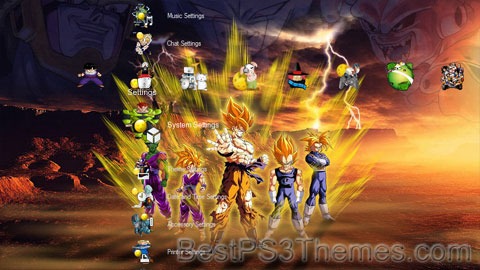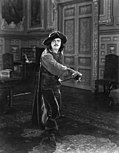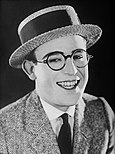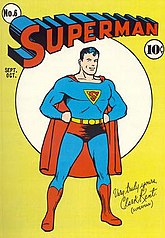Family Guy theme by R2_Joe
Download: FamilyGuy_2.p3t
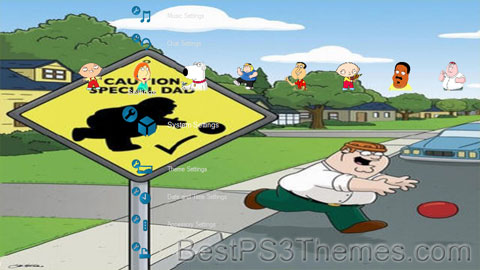
(5 backgrounds)
| Family Guy | |
|---|---|
 | |
| Genre | Animated sitcom[1] |
| Created by | Seth MacFarlane |
| Developed by |
|
| Showrunners |
|
| Voices of |
|
| Theme music composer | Walter Murphy |
| Composers |
|
| Country of origin | United States |
| Original language | English |
| No. of seasons | 22 |
| No. of episodes | 424 (list of episodes) |
| Production | |
| Executive producers |
|
| Producers |
|
| Running time |
|
| Production companies |
|
| Original release | |
| Network | Fox[N 1] |
| Release | January 31, 1999 – February 14, 2002[2][c] |
| Release | May 1, 2005[2] – present |
| Related | |
Family Guy is an American animated sitcom created by Seth MacFarlane for the Fox Broadcasting Company. The series premiered on January 31, 1999, following Super Bowl XXXIII, with the rest of the first season airing from April 11, 1999. The show centers around the Griffins, a dysfunctional family consisting of parents Peter and Lois, their children, Meg, Chris, and Stewie, and their anthropomorphic pet dog, Brian. Set in the fictional city of Quahog, Rhode Island, the show exhibits much of its humor in the form of metafictional cutaway gags that often lampoon American culture.
The family was conceived by MacFarlane after he developed two animated films, The Life of Larry and Larry & Steve. MacFarlane redesigned the films' protagonist, Larry, and his dog, Steve, and renamed them Peter and Brian, respectively. MacFarlane pitched a seven-minute pilot to Fox in December 1998, and the show was greenlit and began production. Family Guy's cancellation was announced shortly after the third season had aired in 2002, with one unaired episode eventually premiering on Adult Swim in 2003, finishing the series' original run. Favorable DVD sales and high ratings from syndicated reruns since then convinced Fox to revive the show in 2004; a fourth season began airing the following year, on May 1, 2005.
Since its premiere, Family Guy has received generally positive reviews. In 2009, it was nominated for a Primetime Emmy Award for Outstanding Comedy Series, the first time an animated series had been nominated for the award since The Flintstones in 1961. In 2013, TV Guide ranked Family Guy as the ninth-greatest TV cartoon.[3] Although highly satirical in nature, the series has also garnered considerable amounts of criticism and controversy, ranging from storylines and character stereotypes, to allegations of racism, homophobia, and sexism.
Many tie-in media based on the show have been released, including Stewie Griffin: The Untold Story, a straight-to-DVD special released in 2005; Family Guy: Live in Vegas, a soundtrack-DVD combo released in 2005, featuring music from the show as well as music created by MacFarlane and Walter Murphy; a video game and pinball machine, released in 2006 and 2007, respectively; since 2005, six books published by Harper Adult; and Laugh It Up, Fuzzball: The Family Guy Trilogy (2010), a collection of three episodes parodying the original Star Wars trilogy. A spin-off series, The Cleveland Show, featuring Cleveland Brown, aired from September 27, 2009, to May 19, 2013.
On January 26, 2023, Fox announced that the series had been renewed for seasons 22 and 23, taking the show through the 2024–25 television season.[4] Season 22 premiered on October 1, 2023.[5] Family Guy moved to Wednesday nights beginning March 6, 2024, marking the first time the show airs on a weeknight since 2002.[6]
Premise[edit]
Characters[edit]

The show centers around the adventures and activities of the dysfunctional Griffin family, consisting of father Peter Griffin, a bumbling and clumsy yet well-intentioned blue-collar worker; his wife Lois, a stay-at-home mother and piano teacher (in early episodes) who is a member of the affluent Pewterschmidt family; Meg, their often bullied teenage daughter who is constantly ridiculed or ignored by the family; Chris, their awkward teenage son, who is overweight, unintelligent, unathletic, and in many respects a younger version of his father; and Stewie, their diabolical infant son of ambiguous sexual orientation who is an adult-mannered evil genius and uses stereotypical archvillain phrases. Living with the family is their witty, smoking, martini-swilling, sarcastic, English-speaking anthropomorphic dog Brian, although he is still considered a pet in many ways.[7]
Recurring characters appear alongside the Griffin family. These include the family's neighbors: sex-crazed airline pilot bachelor Glenn Quagmire; deli owner/mail carrier Cleveland Brown and his wife Loretta (later Donna); paraplegic police officer Joe Swanson, his wife Bonnie, their son Kevin and their baby daughter Susie; neurotic Jewish pharmacist Mort Goldman, his wife Muriel, and their geeky and annoying son Neil, and elderly child molester Herbert. TV news anchors Tom Tucker and Diane Simmons, Asian reporter Tricia Takanawa, and Blaccu-Weather meteorologist Ollie Williams also make frequent appearances. Actor James Woods guest stars as himself in multiple episodes, as did Adam West, prior to his death.[citation needed]
Setting[edit]
The primary setting of Family Guy is Quahog (/ˈk(w)oʊhɒɡ/ K(W)OH-hog), a fictional city in Rhode Island that was founded by Peter's ancestor, Griffin Peterson. MacFarlane resided in Providence during his time as a student at Rhode Island School of Design, and the show contains distinct Rhode Island landmarks similar to real-world locations.[8][9] MacFarlane often borrows the names of Rhode Island locations and icons such as Pawtucket and Buddy Cianci for use in the show. MacFarlane, in an interview with Providence's Fox affiliate WNAC-TV, stated that the town is modeled after Cranston, Rhode Island.[10]
Episodes[edit]
| Season | Episodes | Originally aired | Rank | Average Viewers (in millions) | ||
|---|---|---|---|---|---|---|
| First aired | Last aired | |||||
| 1 | 7 | January 31, 1999 | May 16, 1999 | 33 | 14.12[11] | |
| 2 | 21 | September 23, 1999 | August 1, 2000 | 114 | 6.74 | |
| 3 | 22 | July 11, 2001 | November 9, 2003[d] | 125 | 5.61[12] | |
| 4 | 30 | May 1, 2005 | May 21, 2006 | 68 | 7.90[13] | |
| 5 | 18 | September 10, 2006 | May 20, 2007 | 71 | 7.20[14] | |
| 6 | 12 | September 23, 2007 | May 4, 2008 | 84 | 7.94[15] | |
| 7 | 16 | September 28, 2008 | May 17, 2009 | 69 | 7.46[16] | |
| 8 | 21 | September 27, 2009 | June 20, 2010[e] | 53 | 7.13[17] | |
| 9 | 18 | September 26, 2010 | May 22, 2011 | 56 | 6.78[18] | |
| 10 | 23 | September 25, 2011 | May 20, 2012 | 63 | 5.65[19] | |
| 11 | 22 | September 30, 2012 | May 19, 2013 | 62 | 5.39[20] | |
| 12 | 21 | September 29, 2013 | May 18, 2014 | 78 | 4.65[21] | |
| 13 | 18 | September 28, 2014 | May 17, 2015 | 94 | 3.84[22] | |
| 14 | 20 | September 27, 2015 | May 22, 2016 | 111 | 3.09[23] | |
| 15 | 20 | September 25, 2016 | May 21, 2017 | 116 | 2.76[24] | |
| 16 | 20 | October 1, 2017 | May 20, 2018 | 136 | 2.54[25] | |
| 17 | 20 | September 30, 2018 | May 12, 2019 | 131 | 2.35[26] | |
| 18 | 20 | September 29, 2019 | May 17, 2020 | 107[27] | 1.80[27] | |
| 19 | 20 | September 27, 2020 | May 16, 2021 | 120[28] | 1.55[28] | |
| 20 | 20 | September 26, 2021 | May 22, 2022 | 111[29] | 1.25[29] | |
| 21 | 20 | September 25, 2022 | May 7, 2023 | 104[30] | 1.19[30] | |
| 22 | 15 | October 1, 2023 | April 17, 2024 | 115[31] | 1.03[31] | |
Production[edit]
Development[edit]
MacFarlane conceived Family Guy in 1995 while studying animation at the Rhode Island School of Design (RISD).[32] During college, he created his thesis film titled The Life of Larry,[32] which was submitted by his professor at RISD to Hanna-Barbera. MacFarlane was hired by the company.[33] In 1996, MacFarlane created a sequel to The Life of Larry titled Larry and Steve, which featured a middle-aged character named Larry and an intellectual dog, Steve; the short was broadcast in 1997 as one of Cartoon Network's World Premiere Toons.[32]
Executives at Fox saw the Larry shorts and contracted MacFarlane to create a series, titled Family Guy, based on the characters.[9] Fox proposed that MacFarlane complete a 15-minute short and gave him a budget of $50,000.[34] Several aspects of Family Guy were inspired by the Larry shorts.[35] While MacFarlane worked on the series, the characters of Larry and his dog Steve slowly evolved into Peter and Brian.[9][36] MacFarlane stated that the difference between The Life of Larry and Family Guy was that "Life of Larry was shown primarily in my dorm room and Family Guy was shown after the Super Bowl."[35] After the pilot aired, the series was given the greenlight. MacFarlane drew inspiration from several sitcoms such as The Simpsons and All in the Family.[37] Premises were drawn from several 1980s Saturday-morning cartoons he watched as a child, such as The Fonz and the Happy Days Gang and Rubik, the Amazing Cube.[38]
The Griffin family first appeared on the demo that MacFarlane pitched to Fox on May 15, 1998.[39] Family Guy was originally planned to start out as short movies for the sketch show Mad TV, but the plan changed, because MADtv's budget was not large enough to support animation production. MacFarlane noted that he then wanted to pitch it to Fox, as he thought that it was the place to create a prime-time animation show.[37] Family Guy was originally pitched to Fox in the same year as King of the Hill, but
Simpsons #4
The Simpsons theme by jéjé
Download: Simpsons_4.p3t
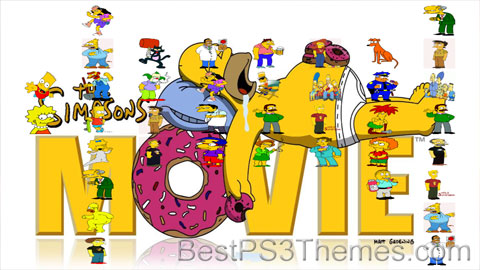
(3 backgrounds)
Redirect to:
This page is a redirect. The following categories are used to track and monitor this redirect:
|
Dragonball Z #3
Superman
Superman theme by Clark Kent
Download: Superman.p3t
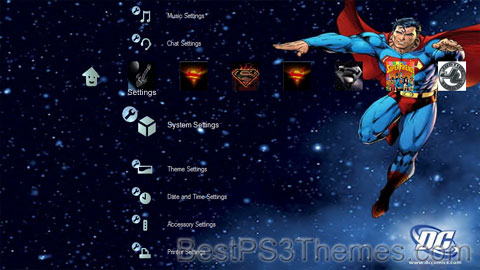
(3 backgrounds)
| Clark Kent / Kal-El Superman | |
|---|---|
 | |
| Publication information | |
| Publisher | DC Comics |
| First appearance | Action Comics #1 (cover-dated June 1938; published April 18, 1938) |
| Created by | Jerry Siegel (writer) Joe Shuster (artist) |
| In-story information | |
| Alter ego | Kal-El (birth name) Clark J. Kent (adopted name) |
| Species | Kryptonian |
| Place of origin | Krypton |
| Team affiliations | |
| Partnerships |
|
| Notable aliases |
|
| Abilities |
|
Superman is a superhero who appears in American comic books published by DC Comics. The character was created by writer Jerry Siegel and artist Joe Shuster, and debuted in the comic book Action Comics #1 (cover-dated June 1938 and published April 18, 1938).[1] Superman has been adapted to a number of other media, which includes radio serials, novels, films, television shows, theater, and video games.
Superman was born on the fictional planet Krypton with the birth name of Kal-El. As a baby, his parents sent him to Earth in a small spaceship shortly before Krypton was destroyed in a natural cataclysm. His ship landed in the American countryside near the fictional town of Smallville, Kansas. He was found and adopted by farmers Jonathan and Martha Kent, who named him Clark Kent. Clark began developing various superhuman abilities, such as incredible strength and impervious skin. His adoptive parents advised him to use his powers for the benefit of humanity, and he decided to fight crime as a vigilante. To protect his personal life, he changes into a colorful costume and uses the alias "Superman" when fighting crime. Clark resides in the fictional American city of Metropolis, where he works as a journalist for the Daily Planet. Superman's supporting characters include his love interest and fellow journalist Lois Lane, Daily Planet photographer Jimmy Olsen, and editor-in-chief Perry White, and his enemies include Brainiac, General Zod, and archenemy Lex Luthor.
Superman is the archetype of the superhero: he wears an outlandish costume, uses a codename, and fights evil with the aid of extraordinary abilities. Although there are earlier characters who arguably fit this definition, it was Superman who popularized the superhero genre and established its conventions. He was the best-selling superhero in American comic books up until the 1980s.[2]
Development[edit]
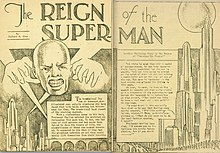
Jerry Siegel and Joe Shuster met in 1932 while attending Glenville High School in Cleveland and bonded over their admiration of fiction. Siegel aspired to become a writer and Shuster aspired to become an illustrator. Siegel wrote amateur science fiction stories, which he self-published as a magazine called Science Fiction: The Advance Guard of Future Civilization. His friend Shuster often provided illustrations for his work.[3] In January 1933, Siegel published a short story in his magazine titled "The Reign of the Superman". The titular character is a homeless man named Bill Dunn who is tricked by an evil scientist into consuming an experimental drug. The drug gives Dunn the powers of mind-reading, mind-control, and clairvoyance. He uses these powers maliciously for profit and amusement, but then the drug wears off, leaving him a powerless vagrant again. Shuster provided illustrations, depicting Dunn as a bald man.[4]
Siegel and Shuster shifted to making comic strips, with a focus on adventure and comedy. They wanted to become syndicated newspaper strip authors, so they showed their ideas to various newspaper editors. However, the newspaper editors told them that their ideas were insufficiently sensational. If they wanted to make a successful comic strip, it had to be something more sensational than anything else on the market. This prompted Siegel to revisit Superman as a comic strip character.[5][6] Siegel modified Superman's powers to make him even more sensational: Like Bill Dunn, the second prototype of Superman is given powers against his will by an unscrupulous scientist, but instead of psychic abilities, he acquires superhuman strength and bullet-proof skin.[7][8] Additionally, this new Superman was a crime-fighting hero instead of a villain, because Siegel noted that comic strips with heroic protagonists tended to be more successful.[9] In later years, Siegel once recalled that this Superman wore a "bat-like" cape in some panels, but typically he and Shuster agreed there was no costume yet, and there is none apparent in the surviving artwork.[10][11]
Siegel and Shuster showed this second concept of Superman to Consolidated Book Publishers, based in Chicago.[12][a] In May 1933, Consolidated had published a proto-comic book titled Detective Dan: Secret Operative 48.[13] It contained all-original stories as opposed to reprints of newspaper strips, which was a novelty at the time.[14] Siegel and Shuster put together a comic book in a similar format called The Superman. A delegation from Consolidated visited Cleveland that summer on a business trip and Siegel and Shuster took the opportunity to present their work in person.[15][16] Although Consolidated expressed interest, they later pulled out of the comics business without ever offering a book deal because the sales of Detective Dan were disappointing.[17][18]
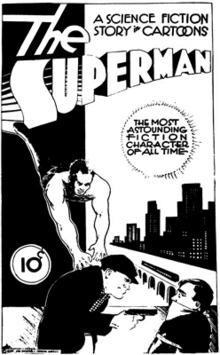
Siegel believed publishers kept rejecting them because he and Shuster were young and unknown, so he looked for an established artist to replace Shuster.[19] When Siegel told Shuster what he was doing, Shuster reacted by burning their rejected Superman comic, sparing only the cover. They continued collaborating on other projects, but for the time being Shuster was through with Superman.[20]
Siegel wrote to numerous artists.[19] The first response came in July 1933 from Leo O'Mealia, who drew the Fu Manchu strip for the Bell Syndicate.[21][22] In the script that Siegel sent to O'Mealia, Superman's origin story changes: He is a "scientist-adventurer" from the far future when humanity has naturally evolved "superpowers". Just before the Earth explodes, he escapes in a time-machine to the modern era, whereupon he immediately begins using his superpowers to fight crime.[23] O'Mealia produced a few strips and showed them to his newspaper syndicate, but they were rejected. O'Mealia did not send to Siegel any copies of his strips, and they have been lost.[24]
In June 1934, Siegel found another partner: an artist in Chicago named Russell Keaton.[25][26] Keaton drew the Buck Rogers and Skyroads comic strips. In the script that Siegel sent Keaton in June, Superman's origin story further evolved: In the distant future, when Earth is on the verge of exploding due to "giant cataclysms", the last surviving man sends his three-year-old son back in time to the year 1935. The time-machine appears on a road where it is discovered by motorists Sam and Molly Kent. They leave the boy in an orphanage, but the staff struggle to control him because he has superhuman strength and impenetrable skin. The Kents adopt the boy and name him Clark, and teach him that he must use his fantastic natural gifts for the benefit of humanity. In November, Siegel sent Keaton an extension of his script: an adventure where Superman foils a conspiracy to kidnap a star football player. The extended script mentions that Clark puts on a special "uniform" when assuming the identity of Superman, but it is not described.[27] Keaton produced two weeks' worth of strips based on Siegel's script. In November, Keaton showed his strips to a newspaper syndicate, but they too were rejected, and he abandoned the project.[28][29]
Siegel and Shuster reconciled and resumed developing Superman together. The character became an alien from the planet Krypton. Shuster designed the now-familiar costume: tights with an "S" on the chest, over-shorts, and a cape.[30][31][32] They made Clark Kent a journalist who pretends to be timid, and conceived his colleague Lois Lane, who is attracted to the bold and mighty Superman but does not realize that he and Kent are the same person.[33]

In June 1935 Siegel and Shuster finally found work with National Allied Publications, a comic magazine publishing company in New York owned by Malcolm Wheeler-Nicholson.[35] Wheeler-Nicholson published two of their strips in New Fun Comics #6 (1935): "Henri Duval" and "Doctor Occult".[36] Siegel and Shuster also showed him Superman and asked him to market Superman to the newspapers on their behalf.[37] In October, Wheeler-Nicholson offered to publish Superman in one of his own magazines.[38] Siegel and Shuster refused his offer because Wheeler-Nicholson had demonstrated himself to be an irresponsible businessman. He had been slow to respond to their letters and had not paid them for their work in New Fun Comics #6. They chose to keep marketing Superman to newspaper syndicates themselves.[39][40] Despite the erratic pay, Siegel and Shuster kept working for Wheeler-Nicholson because he was the only publisher who was buying their work, and over the years they produced other adventure strips for his magazines.[41]
Wheeler-Nicholson's financial difficulties continued to mount. In 1936, he formed a joint corporation with Harry Donenfeld and Jack Liebowitz called Detective Comics, Inc. in order to release his third magazine, which was titled Detective Comics. Siegel and Shuster produced stories for Detective Comics too, such as "Slam Bradley". Wheeler-Nicholson fell into deep debt to Donenfeld and Liebowitz, and in early January 1938, Donenfeld and Liebowitz petitioned Wheeler-Nicholson's company into bankruptcy and seized it.[3][42]
In early December 1937, Siegel visited Liebowitz in New York, and Liebowitz asked Siegel to produce some comics for an upcoming comic anthology magazine called Action Comics.[43][44] Siegel proposed some new stories, but not Superman. Siegel and Shuster were, at the time, negotiating a deal with the McClure Newspaper Syndicate for Superman. In early January 1938, Siegel had a three-way telephone conversation with Liebowitz and an employee of McClure named Max Gaines. Gaines informed Siegel that McClure had rejected Superman, and asked if he could forward their Superman strips to Liebowitz so that Liebowitz could consider them for Action Comics. Siegel agreed.[45] Liebowitz and his colleagues were impressed by the strips, and they asked Siegel and Shuster to develop the strips into 13 pages for Action Comics.[46] Having grown tired of rejections, Siegel and Shuster accepted the offer. At least now they would see Superman published.[47][48] Siegel and Shuster submitted their work in late February and were paid $130 (equivalent to $2,814 in 2023) for their work ($10 per page).[49] In early March they signed a contract at Liebowitz's request in which they gave away the copyright for Superman to Detective Comics, Inc. This was normal practice in the business, and Siegel and Shuster had given away the copyrights to their previous works as well.[50]
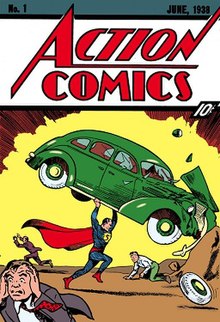
The duo's revised version of Superman appeared in the first issue of Action Comics, which was published on April 18, 1938. The issue was a huge success thanks to Superman's feature.[1][51][52]
Influences[edit]
Siegel and Shuster read pulp science-fiction and adventure magazines, and many stories featured characters with fantastical abilities such as telepathy, clairvoyance, and superhuman strength. One character in particular was John Carter of Mars from the novels by Edgar Rice Burroughs. John Carter is a human who is transported to Mars, where the lower gravity makes him stronger than the natives and allows him to leap great distances.[53][54] Another influence was Philip Wylie's 1930 novel Gladiator, featuring a protagonist named Hugo Danner who had similar powers.[55][56]
Superman's stance and devil-may-care attitude were influenced by the characters of Douglas Fairbanks, who starred in adventure films such as The Mark of Zorro and Robin Hood.[57] The name of Superman's home city, Metropolis, was taken from the 1927 film of the same name.[58] Popeye cartoons were also an influence.[58]
Clark Kent's harmless facade and dual identity were inspired by the protagonists of such movies as Don Diego de la Vega in The Mark of Zorro and Sir Percy Blakeney in The Scarlet Pimpernel. Siegel thought this would make for interesting dramatic contrast and good humor.[59][60] Another inspiration was slapstick comedian Harold Lloyd. The archetypal Lloyd character was a mild-mannered man who finds himself abused by bullies but later in the story snaps and fights back furiously.[61]
Kent is a journalist because Siegel often imagined himself becoming one after leaving school. The love triangle between Lois Lane, Clark, and Superman was inspired by Siegel's own awkwardness with girls.[62]
The pair collected comic strips in their youth, with a favorite being Winsor McCay's fantastical Little Nemo.[58] Shuster remarked on the artists who played an important part in the development of his own style: "Alex Raymond and Burne Hogarth were my idols – also Milt Caniff, Hal Foster, and Roy Crane."[58] Shuster taught himself to draw by tracing over the art in the strips and magazines they collected.[3]
As a boy, Shuster was interested in fitness culture[63] and a fan of strongmen such as Siegmund Breitbart and Joseph Greenstein. He collected fitness magazines and manuals and used their photographs as visual references for his art.[3]
The visual design of Superman came from multiple influences. The tight-fitting suit and shorts were inspired by the costumes of wrestlers, boxers, and strongmen. In early concept art, Shuster gave Superman laced sandals like those of strongmen and classical heroes, but these were eventually changed to red boots.[34] The costumes of Douglas Fairbanks were also an influence.[64] The emblem on his chest was inspired by heraldic crests.[65] Many pulp action heroes such as swashbucklers wore capes. Superman's face was based on Johnny Weissmuller with touches derived from the comic-strip character Dick Tracy and from the work of cartoonist Roy Crane.[66]
The word "superman" was commonly used in the 1920s and 1930s to describe men of great ability, most often athletes and politicians.[67] It occasionally appeared in pulp fiction stories as well, such as "The Superman of Dr. Jukes".[68] It is unclear whether Siegel and Shuster were influenced by Friedrich Nietzsche's concept of the Übermensch; they never acknowledged as much.[69]
Comics[edit]
Comic books[edit]
Since 1938, Superman stories have been regularly published in periodical comic books published by DC Comics. The first and oldest of these is Action Comics, which began in April 1938.[1] Action Comics was initially an anthology magazine, but it eventually became dedicated to Superman stories. The second oldest periodical is Superman, which began in June 1939. Action Comics and Superman have been published without interruption (ignoring changes to the title and numbering scheme).[71][72] A number of other shorter-lived Superman periodicals have been published over the years.[73] Superman is part of the DC Universe, which is a shared setting of superhero characters owned by DC Comics, and consequently he frequently appears in stories alongside the likes of Batman, Wonder Woman, and others.
Superman has sold more comic books over his publication history than any other American superhero character.[74] Exact sales figures for the early decades of Superman comic books are hard to find because, like most publishers at the time, DC Comics concealed this data from its competitors and thereby the general public as well, but given the general market trends at the time, sales of Action Comics and Superman probably peaked in the mid-1940s and thereafter steadily declined.[75] Sales data first became public in 1960, and showed that Superman was the best-selling comic book character of the 1960s and 1970s.[2][76][77] Sales rose again starting in 1987. Superman #75 (Nov 1992) sold over 23 million copies,[78] making it the best-selling issue of a comic book of all time, thanks to a media sensation over the supposedly permanent death of the character in that issue.[79] Sales declined from that point on. In March 2018, Action Comics sold just 51,534 copies, although such low figures are normal for superhero comic books in general (for comparison, Amazing Spider-Man #797 sold only 128,189 copies).[80] The comic books are today considered a niche aspect of the Superman franchise due to low readership,[81] though they remain influential as creative engines for the movies and television shows. Comic book stories can be produced quickly and cheaply, and are thus an ideal medium for experimentation.[82]
Whereas comic books in the 1950s were read by children, since the 1990s the average reader has been an adult.[83] A major reason for this shift was DC Comics' decision in the 1970s to sell its comic books to specialty stores instead of traditional magazine retailers (supermarkets, newsstands, etc.) — a model called "direct distribution". This made comic books less accessible to children.[84]
Newspaper strips[edit]
Beginning in January 1939, a Superman daily comic strip appeared in newspapers, syndicated through the McClure Syndicate. A color Sunday version was added that November. Jerry Siegel wrote most of the strips until he was conscripted in 1943. The Sunday strips had a narrative continuity separate from the daily strips, possibly because Siegel had to delegate the Sunday strips to ghostwriters.[85] By 1941, the newspaper strips had an estimated readership of 20 million.[86] Joe Shuster drew the early strips, then passed the job to Wayne Boring.[87] From 1949 to 1956, the newspaper strips were drawn by Win Mortimer.[88] The strip ended in May 1966, but was revived from 1977 to 1983 to coincide with a series of movies released by Warner Bros.[89]
Editors[edit]
Initially, Siegel was allowed to write Superman more or less as he saw fit because nobody had anticipated the success and rapid expansion of the franchise.[90][91] But soon Siegel and Shuster's work was put under careful oversight for fear of trouble with censors.[92] Siegel was forced to tone down the violence and social crusading that characterized his early stories.[93] Editor Whitney Ellsworth, hired in 1940, dictated that Superman not kill.[94] Sexuality was banned, and colorfully outlandish villains such as Ultra-Humanite and Toyman were thought to be less nightmarish for young readers.[95]
Mort Weisinger was the editor on Superman comics from 1941 to 1970, his tenure briefly interrupted by military service. Siegel and his fellow writers had developed the character with little thought of building a coherent mythology, but as the number of Superman titles and the pool of writers grew, Weisinger demanded a more disciplined approach.[96] Weisinger assigned story ideas, and the logic of Superman's powers, his origin, the locales, and his relationships with his growing cast of supporting characters were carefully planned. Elements such as Bizarro, his cousin Supergirl, the Phantom Zone, the Fortress of Solitude, alternate varieties of kryptonite, robot doppelgangers, and Krypto were introduced during this era. The complicated universe built under Weisinger was beguiling to devoted readers but alienating to casuals.[97] Weisinger favored lighthearted stories over serious drama, and avoided sensitive subjects such as the Vietnam War and the American civil rights movement because he feared his right-wing views would alienate his left-leaning writers and readers.[98] Weisinger also introduced letters columns in 1958 to encourage feedback and build intimacy with readers.[99]
Weisinger retired in 1970 and Julius Schwartz took over. By his own admission, Weisinger had grown out of touch with newer readers.[100] Starting with The Sandman Saga, Schwartz updated Superman by making Clark Kent a television anchor, and he retired overused plot elements such as kryptonite and robot doppelgangers.[101] Schwartz also scaled Superman's powers down to a level closer to Siegel's original. These changes would eventually be reversed by later writers. Schwartz allowed stories with serious drama such as "For the Man Who Has Everything" (Superman Annual #11), in which the villain Mongul torments Superman with an illusion of happy family life on a living Krypton.
Schwartz retired from DC Comics in 1986 and was succeeded by Mike Carlin as an editor on Superman comics. His retirement coincided with DC Comics' decision to reboot the DC Universe with the companywide-crossover storyline "Crisis on Infinite Earths". In The Man of Steel writer John Byrne rewrote the Superman mythos, again reducing Superman's powers, which writers had slowly re-strengthened, and revised many supporting characters, such as making Lex Luthor a billionaire industrialist rather than a mad scientist, and making Supergirl an artificial shapeshifting organism because DC wanted Superman to be the sole surviving Kryptonian.
Carlin was promoted to Executive Editor for the DC Universe books in 1996, a position he held until 2002. K.C. Carlson took his place as editor of the Superman comics.
Aesthetic style[edit]
In the earlier decades of Superman comics, artists were expected to conform to a certain "house style".[102] Joe Shuster defined the
The Sarah Connor Chronicles
The Sarah Connor Chronicles theme by Markese Jackson
Download: SarahConnorChronicles.p3t

(16 backgrounds)
Redirect to:
This page is a redirect. The following categories are used to track and monitor this redirect:
|
Transformers #4
Transformers theme by jéjé
Download: Transformers_4.p3t
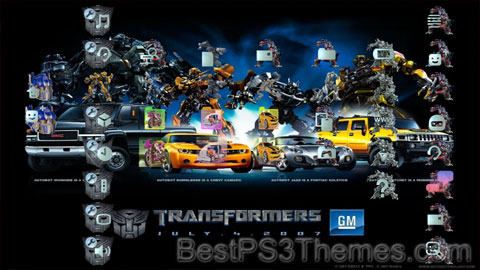
(8 backgrounds)
| Transformers | |
|---|---|
Franchise logo, 2014–present | |
| Created by | |
| Original work | Transformers (based on Diaclone and Micro Change) |
| Years | 1984–present |
| Print publications | |
| Book(s) | Complete list |
| Comics | Complete list |
| Films and television | |
| Film(s) | Animated |
| Animated series | Complete list |
| Games | |
| Video game(s) | Complete list |
| Audio | |
| Soundtrack(s) | Transformers audio releases |
| Miscellaneous | |
| Related franchises | |
Transformers is a media franchise produced by American toy company Hasbro and Japanese toy company Takara Tomy. It primarily follows the heroic Autobots and the villainous Decepticons, two alien robot factions at war that can transform into other forms, such as vehicles and animals. The franchise encompasses toys, animation, comic books, video games and films. As of 2011, it generated more than ¥2 trillion ($25 billion) in revenue,[1] making it one of the highest-grossing media franchises of all time.
The franchise began in 1984 with the Transformers toy line, comprising transforming mecha toys from Takara's Diaclone and Micro Change toylines rebranded for Western markets.[2] The term "Generation 1" covers both the animated television series The Transformers and the comic book series of the same name, which are further divided into Japanese, British and Canadian spin-offs, respectively. Sequels followed, such as the Generation 2 comic book and Beast Wars TV series, which became its own mini-universe. Generation 1 characters have been rebooted multiple times in the 21st century in comics from Dreamwave Productions (starting 2001), IDW Publishing (starting in 2005 and again in 2019), and Skybound Entertainment (beginning in 2023). There have been other incarnations of the story based on different toy lines during and after the 20th century. The first was the Robots in Disguise series, followed by three shows (Armada, Energon, and Cybertron) that constitute a single universe called the "Unicron Trilogy".
A live-action film series started in 2007, again distinct from previous incarnations, while the Transformers: Animated series merged concepts from the G1 continuity, the 2007 live-action film and the "Unicron Trilogy". For most of the 2010s, in an attempt to mitigate the wave of reboots, the "Aligned Continuity" was established. In 2018, Transformers: Cyberverse debuted, once again, distinct from the previous incarnations.
Although initially a separate and competing franchise started in 1983, Tonka's GoBots became the intellectual property of Hasbro after their buyout of Tonka in 1991. Subsequently, the universe depicted in the animated series Challenge of the GoBots and follow-up film GoBots: Battle of the Rock Lords was retroactively established as an alternate universe within the Transformers multiverse.[3]
Fiction[edit]
Transformers: Generation 1 (1984–1993)[edit]


Generation One is a retroactive term for the Transformers characters that appeared between 1984 and 1993. The Transformers began with the 1980s Japanese toy lines Micro Change and Diaclone. They presented robots able to transform into everyday vehicles, electronic items or weapons. Hasbro bought the Micro Change and Diaclone toys, and partnered with Takara.[4] Marvel Comics was hired by Hasbro to create the backstory; editor-in-chief Jim Shooter wrote an overall story, and gave the task of creating the characters to writer Dennis O'Neil.[5] Unhappy with O'Neil's work (although O'Neil created the name "Optimus Prime"), Shooter chose Bob Budiansky to create the characters.[6]
The Transformers mecha were largely designed by Shōji Kawamori, the creator of the Japanese mecha anime franchise Macross (which was adapted into the Robotech franchise in North America).[7] Kawamori came up with the idea of transforming mechs while working on the Diaclone and Macross franchises in the early 1980s (such as the VF-1 Valkyrie in Macross and Robotech), with his Diaclone mechs later providing the basis for Transformers.[8]
The primary concept of Generation One is that the heroic Optimus Prime, the villainous Megatron, and their finest soldiers crash-land on prehistoric Earth in the Ark and the Nemesis before awakening in 1985, Cybertron hurtling through the Neutral zone as an effect of the war. The Marvel comic was originally part of the main Marvel Universe, with appearances from Spider-Man and Nick Fury, plus some cameos,[9] as well as a visit to the Savage Land.[10]
The Transformers TV series began around the same time. Produced by Sunbow Productions and Marvel Productions, later Hasbro Productions, from the start it contradicted Budiansky's backstories. The TV series shows the Autobots looking for new energy sources, and crash landing as the Decepticons attack.[11] Marvel interpreted the Autobots as destroying a rogue asteroid approaching Cybertron.[12] Shockwave is loyal to Megatron on the TV series, keeping Cybertron in a stalemate during his absence,[13] but in the comic book, he attempts to take command of the Decepticons.[14] The TV series would also differ wildly from the origins Budiansky had created for the Dinobots,[15][16] the Decepticon turned Autobot Jetfire[17] (known as Skyfire on TV[18]), the Constructicons (who combine to form Devastator),[19][20] and Omega Supreme.[19][21] The Marvel comic establishes early on that Prime wields the Creation Matrix, which gives life to machines. In the second season, the two-part episode The Key to Vector Sigma introduced the ancient Vector Sigma computer, which served the same original purpose as the Creation Matrix (giving life to Transformers), and its guardian Alpha Trion.
In 1986, the cartoon became the film The Transformers: The Movie, which is set in the year 2005. It introduced the Matrix as the "Autobot Matrix of Leadership", as a fatally wounded Prime gives it to Ultra Magnus; however, as Prime dies he drops the matrix, which is then caught by Hot Rod who subsequently becomes Rodimus Prime later on in the film. Unicron, a Transformer who devours planets, fears its power and re-creates a heavily damaged Megatron as Galvatron, as well as Bombshell or Skywarp becoming Cyclonus, Thundercracker becoming Scourge and two other Insecticons becoming Scourge's huntsmen, the Sweeps. Eventually, Rodimus Prime takes out the Matrix and destroys Unicron.[22] In the United Kingdom, the weekly comic book interspliced original material to keep up with U.S. reprints,[23] and The Movie provided much new material. Writer Simon Furman proceeded to expand the continuity with movie spin-offs involving the time travelling Galvatron.[24][25] The Movie also featured guest voices from Leonard Nimoy as Galvatron, Scatman Crothers as Jazz, Casey Kasem as Cliffjumper, Orson Welles as Unicron and Eric Idle as the leader of the Junkions (Wreck-Gar, though unnamed in the movie). The Transformers theme tune for the film was performed by Lion with "Weird Al" Yankovic adding a song to the soundtrack.
The third season followed up The Movie, with the revelation of the Quintessons having used Cybertron as a factory. Their robots rebel, and in time the workers become the Autobots and the soldiers become the Decepticons. (Note: This appears to contradict background presented in the first two seasons of the series.) It is the Autobots who develop transformation.[26] Due to popular demand,[27] Optimus Prime is resurrected at the conclusion of the third season,[28] and the series ended with a three-episode story arc. However, the Japanese broadcast of the series was supplemented with a newly produced OVA, Scramble City, before creating entirely new series to continue the storyline, ignoring the 1987 end of the American series. The extended Japanese run consisted of The Headmasters, Super-God Masterforce, Victory and Zone, then in illustrated magazine form as Battlestars: Return of Convoy and Operation: Combination. Just as the TV series was wrapping up, Marvel continued to expand its continuity. It follows The Movie's example by killing Prime[29] and Megatron,[30] albeit in the present day. Dinobot leader Grimlock takes over as Autobot leader.[31] There was a G.I. Joe crossover[32] and the limited series The Transformers: Headmasters, which further expanded the scope to the planet Nebulon.[33] It led on to the main title resurrecting Prime as a Powermaster.[34]
In the United Kingdom, the mythology continued to grow. Primus is introduced as the creator of the Transformers, to serve his material body that is planet Cybertron and fight his nemesis Unicron.[35] Female Autobot Arcee also appeared, despite the comic book stating the Transformers had no concept of gender, with her backstory of being built by the Autobots to quell human accusations of sexism.[36] Soundwave, Megatron's second-in-command, also breaks the fourth wall in the letters page, criticising the cartoon continuity as an inaccurate representation of history.[37] The UK also had a crossover in Action Force, the UK counterpart to G.I. Joe.[38] The comic book features a resurrected Megatron,[39] whom Furman retconned to be a clone[40] when he took over the U.S. comic book, which depicted Megatron as still dead.[41] The U.S. comic would last for 80 issues until 1991,[42] and the UK comic lasted 332 issues and several annuals, until it was replaced as Dreamwave Productions, later in the 20th-Century.
In 2009, Shout! Factory released the entire G1 series in a 16-DVD box set called the Matrix of Leadership Edition.[43] They also released the same content as individual seasons.[44]
Transformers: Generation 2 (1993–1995)[edit]
It was five issues[45] of the G.I. Joe comic in 1993 that would springboard a return for Marvel's Transformers, with the new twelve-issue series Transformers: Generation 2, to market a new toy line.
This story reveals that the Transformers originally breed asexually, though it is stopped by Primus because it produced the evil Swarm.[46] A new empire, neither Autobot nor Decepticon, is bringing it back, however. Though the year-long arc wrapped itself up with an alliance between Optimus Prime and Megatron, the final panel introduces the Liege Maximo, ancestor of the Decepticons.[47] This minor cliffhanger was not resolved until 2001 and 2002's Transforce convention when writer Simon Furman concluded his story in the exclusive novella Alignment.[48]
Beast Wars and Beast Machines (1996–2000)[edit]
The story focuses on a small group of Maximals (the new Autobots), led by Optimus Primal, and Predacons, led by Megatron, 300 years after the "Great War". After a dangerous pursuit through transwarp space, both the Maximal and Predacon factions end up crash landing on a primitive, uncivilized planet similar to Earth, but with two moons and a dangerous level of Energon (which is later revealed to be prehistoric Earth with an artificial second moon, taking place sometime during the 4 million year period in which the Autobots and Decepticons were in suspended animation from the first episode of the original Transformers cartoon), which forces them to take organic beast forms in order to function without going into stasis lock.[49] After writing this first episode, Bob Forward and Larry DiTillio learned of the G1 Transformers and began to use elements of it as a historical backstory to their scripts,[50] establishing Beast Wars as a part of the Generation 1 universe through numerous callbacks to both the cartoon and the Marvel comic. By the end of the first season, the second moon and the Energon are revealed to have been constructed by a mysterious alien race known as the Vok.

The destruction of the second moon releases mysterious energies that make some of the characters "transmetal" and the planet is revealed to be prehistoric Earth, leading to the discovery of the Ark. Megatron attempts to kill the original Optimus Prime,[51] but at the beginning of the third season, Primal manages to preserve his spark. In the two-season follow-up series, Beast Machines, Cybertron is revealed to have organic origins, which Megatron attempts to stamp out.
After the first season of Beast Wars (comprising 26 episodes) aired in Japan, the Japanese were faced with a problem. The second Canadian season was only 13 episodes long, not enough to warrant airing on Japanese TV. While they waited for the third Canadian season to be completed (thereby making 26 episodes in total when added to season 2), they produced two exclusive cel-animated series of their own, Beast Wars II (also called Beast Wars Second) and Beast Wars Neo, to fill in the gap. Dreamwave retroactively revealed Beast Wars to be the future of their G1 universe,[52] and the 2006 IDW comic book Beast Wars: The Gathering eventually confirmed the Japanese series to be canon[53] within a story set during Season 3.[54]
Beast Wars contained elements from both the G1 cartoon series and comics. Attributes taken from the cartoon include Transformers that were female, the appearance of Starscream (who mentions being killed off by Galvatron in The Transformers: The Movie), and appearances of the Plasma Energy Chamber and Key to Vector Sigma. The naming of the Transformer ship, the Ark (and reference to 1984, the year the Transformers on board are revived), the character Ravage being shown as intelligent, and Cybertron having an organic core are elements taken from the comics.
In 2011, Shout! Factory released the complete series of Beast Wars on DVD.[55]
Dreamwave Productions (2001–2005)[edit]
In 2001, Dreamwave Productions began a new universe of annual comics adapted from Marvel, but also included elements of the animated. The Dreamwave stories followe the concept of the Autobots defeating the Decepticons on Earth, but their 1997 return journey to Cybertron on the Ark II[56] is destroyed by Shockwave, now ruler of the planet.[57] The story follows on from there and was told in two six-issue limited series, then a ten-issue ongoing series. The series also adds extra complexities such as not all Transformers believing in the existence of Primus,[58] corruption in the Cybertronian government that first led Megatron to begin his war,[59] and Earth having an unknown relevance to Cybertron.[57][60]
Three Transformers: The War Within limited series were also published. These are set at the beginning of the Great War, and identify Prime as once being a clerk named Optronix.[61] Beast Wars was also retroactively stated as the future of this continuity, with the profile series More than Meets the Eye showing the Predacon Megatron looking at historical files detailing Dreamwave's characters and taking his name from the original Megatron.[52] In 2004, this real life universe also inspired three novels[62] and a Dorling Kindersley guide, which focused on Dreamwave as the "true" continuity when discussing in-universe elements of the characters. In a new twist, Primus and Unicron are siblings, formerly a being known as the One. Transformers: Micromasters, set after the Ark's disappearance, was also published. The real life universe was disrupted when Dreamwave went bankrupt in 2005.[63] This left the Generation One story hanging and the third volume of The War Within half finished. Plans for a comic book set between Beast Wars and Beast Machines were also left unrealized.[64]
G.I. Joe crossovers (2003–present)[edit]
Throughout the years, the G1 characters have also starred in crossovers with fellow Hasbro property G.I. Joe, but whereas those crossovers published by Marvel were in continuity with their larger storyline, those released by Dreamwave and G.I. Joe publisher Devil's Due Publishing occupy their own separate real life universes. In Devil's Due, the terrorist organization Cobra is responsible for finding and reactivating the Transformers. Dreamwave's version reimagines the familiar G1 and G.I. Joe characters in a World War II setting, and a second limited series was released set in the present day, though Dreamwave's bankruptcy meant it was cancelled after a single issue. Devil's Due had Cobra re-engineer the Transformers to turn into familiar Cobra vehicles, and released further mini-series that sent the characters travelling through time, battling Serpentor and being faced with the combined menace of Cobra-La and Unicron. During this time, Cobra teams up with the Decepticons. IDW Publishing has expressed interest in their own crossover.[65]
IDW publishing (2005–2022)[edit]
The following year, IDW Publishing rebooted the G1 series from scratch within various limited series and one shots. This allowed long-time writer of Marvel and Dreamwave comics, Simon Furman to create his own universe without continuity hindrance, similar to Ultimate Marvel. This new continuity originally consisted of a comic book series titled The Transformers with a companion series known as The Transformers: Spotlight. The main series was broken up into several story arcs. Eventually, with IDW Publishing losing sales, the series was given a soft reboot. Beginning with All Hail Megatron, the series was set in a new direction, discarding the miniseries and Spotlight format with ongoing comics. By 2012 the series had split into three ongoing series; The Transformers: More Than Meets The Eye, The Transformers: Robots in Disguise (which later changed in 2015 to "The Transformers") and The Transformers: Till All Are One. In 2022, it was announced that IDW lost the publishing rights to Transformers.[66]
Alternative stories[edit]
In January 2006, the Hasbro Transformers Collectors' Club comic wrote a story based on the Transformers Classics toy line, set in the Marvel Comics universe, but excluding the Generation 2 comic. Fifteen years after Megatron crash-lands in the Ark with Ratchet, the war continues with the characters in their Classics bodies.[67]
IDW Publishing introduced The Transformers: Evolutions in 2006, a collection of mini-series that re-imagine and reinterpret the G1 characters in various ways. To date, only one miniseries has been published, Hearts of Steel, placing the characters in an Industrial Revolution-era setting. The series was delayed as Hasbro did not want to confuse newcomers with too many fictional universes before the release of the live-action film.[68]
However, IDW and the original publisher Marvel Comics announced a crossover storyline with the Avengers to coincide with the film New Avengers/Transformers.[69] The story is set on the borders of Symkaria and Latveria, and its fictional universe is set between the first two New Avengers storylines, as well in between the Infiltration and Escalation phase of IDW's The Transformers.[70] IDW editor-in-chief, Chris Ryall hinted at elements of it being carried over into the main continuities,[71] and that a sequel is possible.[72] In June 2018 it was announced there would be Star Trek and Transformers Crossover being released in September 2018.[73]
Transformers: Kiss Players (2006–2007)[edit]
Transformers: Kiss Players (トランスフォーマー キスぷれ, Toransufōmā Kisu Pure), shortened to Kiss Players (キスぷれ, Kisu Pure), is a Japanese Transformers franchise which began in 2006 to 2007 as was helmed by artist and writer Yuki Ohshima. By virtue of being the only Transformers toyline and fiction released in Japan by Takara between the conclusion of Cybertron and the live-acti
The Office
The Office theme by ryanindy124
Download: TheOffice.p3t
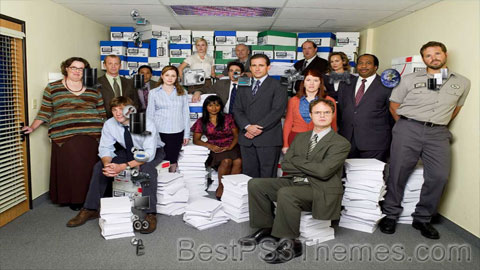
(5 backgrounds)

The Office is the title of a number of mockumentary sitcoms based on a British series originally created by Ricky Gervais and Stephen Merchant as The Office in 2001. The original series also starred Gervais as the boss and main character of the show. The two seasons were broadcast on BBC Two in 2001 and 2002, totalling 12 episodes, with two special episodes in 2003, and an extra short spectacular ten years later.[1] Versions of the original were subsequently made in Germany, the United States, and many other countries.
The longest-running version of the series, the U.S. adaptation, ran for nine seasons on the NBC Television Network from 2005 to 2013, with a total of 201 episodes. According to Nielsen Ratings as of April 2019, the US version of The Office was the No. 1 streamed show on Netflix in the United States.[2] A follow-up of the US version was announced in late 2023 following the end of the labor disputes in Hollywood and has been picked up by Peacock, a streaming service owned by NBCUniversal Media Group.[3]
International versions[a][edit]
| Country/Region | Title | Network | Original run |
|---|---|---|---|
| The Office Australia | Amazon Prime Video | 2024 (in production from June 2023)[5][6] | |
| La Job | 2006, 9 October – 2007, 1 January | ||
| La ofis | Canal 13 | 2008, 6 August – 2008, 22 November | |
| Kancl | ČT1 | 2014, 1 December – 2014, 17 December | |
| Konttori | Nelonen | 2017, 3 March – 2019, 15 February | |
| Le Bureau | Canal+ | 2006, 25 May – 2006, 30 June | |
| Stromberg[b] | ProSieben | 2004, 11 October – 2012, 31 January | |
| TBA | ANT1 | TBA, 2023 | |
| The Office | Hotstar | 2019, 28 June – 2019, 15 September | |
| HaMisrad | yes Comedy | 2010, 10 August – 2013, 3 October | |
| The Office PL | Canal+ | 2021, 22 October – 2023, 24 November | |
| Al Maktab | MBC | 2022, 28 October – 2023, 6 January[7][8][9] | |
| Kontoret | TV4 | 2012, 12 February – 2013, 17 March | |
| The Office | BBC Two | 2001, 9 July – 2003, 27 December | |
| The Office | NBC | 2005, 24 March – 2013, 16 May |
Counterparts[edit]
| English-language | German-language | French-language | Spanish-language | Hebrew-language | Swedish-language | Czech-language | Finnish-language | Hindi-language | Polish-language | |||
|---|---|---|---|---|---|---|---|---|---|---|---|---|
| Name | The Office | The Office | Stromberg | Le Bureau ("The Office") |
La Job ("The Job") |
La ofis ("The Office") |
HaMisrad (המשרד, "The Office") | Kontoret ("The Office") |
Kancl ("The Office") | Konttori ("The Office") |
The Office | The Office PL |
| Firm | Wernham Hogg | Dunder Mifflin[c] | Capitol-Versicherung AG | Cogirep | Les Papiers Jennings | Papeles Lozano | פייפר אופיס (Piper Office) | Svensk kontorshygien AB | Papír a print | Leskisen paperi | Wilkins Chawla | Kropliczanka |
| Business | Paper | Paper and Office Supplies[c] | Insurance | Paper | Paper | Paper | Office supplies | Office hygiene | Paper | Paper | Paper | Mineral water |
| Location | Slough | Scranton | Unspecified, but filmed in Cologne | Villepinte | Côte-de-Liesse | Santiago Centro | Yehud | Upplands-Väsby | Brno | Riihimäki | Faridabad | Siedlce |
| Regional Manager |
David Brent (Ricky Gervais) |
Michael Scott (Steve Carell) Andy Bernard (Ed Helms) |
Bernd Stromberg (Christoph Maria Herbst) |
Gilles Triquet (François Berléand) |
David Gervais (Antoine Vézina) |
Manuel Cerda (Luis Gnecco) |
Avi Meshulam (Dvir Benedek) |
Ove Sundberg (Henrik Dorsin) |
Marek Chvála | Pentti Markkanen (Sami Hedberg) |
Jagdeep Chadda (Mukul Chadda) |
Michał Holc (Piotr Polak) president Patrycja Kowalska (Vanessa Aleksander) S1: vicepresident S2: co-president S3: member of the board |
| Senior Sales Representative |
Tim Canterbury (Martin Freeman) |
Jim Halpert (John Krasinski) |
Ulf Steinke (Oliver Wnuk) |
Paul Delorme (Jérémie Elkaïm) |
Louis Tremblay (Sébastien Huberdeau) |
Diego Ramírez (Pablo Cazals) |
Yossi (Eldad Fribas) |
Erik Lundkvist (Kim Sulocki) |
Tomáš Trojan (Michal Dalecký) |
Timo (Pyry Äikää) |
Amit Sharma (Sayandeep Sengupta) |
S1: Franek Wójcik (Mikołaj Matczak) since S2: Adam Szeliga (Rafał Kowalski) new marketing specialist |
| Assistant (to the) Regional Manager | Gareth Keenan (Mackenzie Crook) |
Dwight Schrute (Rainn Wilson) |
Berthold "Ernie" Heisterkamp (Bjarne Mädel) |
Joel Liotard (Benoît Carré) |
Sam Bisaillon (Paul Ahmarani) |
Cristián Müller (Mauricio Dell) |
Yariv Shauli (Maayan Blum) |
Viking Ytterman (Björn Gustafsson) |
Jáchym Kořen (Radim Novák) |
Jaakko (Antti Heikkinen) |
T.P. Mishra (Gopal Datt) |
Darek Wasiak (Adam Woronowicz) head of the logistics department |
| Receptionists | Dawn Tinsley (Lucy Davis) |
Pam Beesly (Jenna Fischer) Erin Hannon (Ellie Kemper) |
Tanja Seifert (Diana Staehly) |
Laetitia Kadiri (Anne-Laure Balbir) |
Anne Viens (Sophie Cadieux) |
Rocío Poblete (Nathalia Aragonese) |
Dana (Mali Levi) |
Therese Johansson (Sissela Benn) |
Anna Kručinská (Sara Venclovská) |
Anna (Linda Wiklund) |
Pammi (Samridhi Dewan) |
Asia Kasprzyk (Kornelia Strzelecka) |
| Temp | Ricky Howard (Oliver Chris) |
Ryan Howard (B. J. Novak) |
Jonas Fischer (Max Mauff) |
Felix Pradier (Xavier Robic) |
– |
Felipe Tomic (César Sepúlveda) |
Regev Steiner (Amir Wolf) |
–
|
Ota Kačer (Jiří Hájek) |
"OP" (K. Puura) |
Sapan Gill (Abhinav Sharma) |
–
|
| Corporate Supervisors |
Jennifer Taylor‑Clarke (Stirling Gallacher) Neil Godwin |
Jan Levinson (Melora Hardin) Gabe Lewis (Zach Woods) |
Tatjana Berkel (Tatjana Alexander) |
Juliette Lebrac (Astrid Bas) |
Emmanuelle Sirois-Keaton (Nathalie Coupal) |
Jimena Ibarra (Liliana García) |
Yelena (Helena Yaralova) |
Idun Falkenberg (Lisa Linnertorp) |
Lenka Falešníková-Vondráčková (Pavla Vitázková) |
Katariina (Vera Kiiskinen) |
Riya Pahwa (Gauahar Khan) |
CEO - Patrycja's father (Tomasz Sapryk) Patryk Kowalski (Maciej Musiałowski) |
| Accountants | Sheila (Jane Lucas) |
Angela Martin (Angela Kinsey) |
– | Daniel Gabarda (Frédéric Merlo) |
– | Yanni (Jimena Nuñez) Teresita (Luz María Yacometti) |
Karol (Roberto Pollak) Ababa "Avi" Sharon (Yossi Vassa) |
Lennart Forsström (Rikard Ulvshammar) Anna Norén (Anna Åström) Margareta Wivallius (Ingbritt Hjälm) |
Petra (Barbora Sousa) |
Maarit (Lotta Lindroos) |
Anjali (Priyanka Setia) |
Sebastian Sołtys (Jan Sobolewski) |
| Oliver (Howard Saddler) |
Oscar Martinez (Oscar Nunez) |
Viktor (Tomáš Sýkora) |
Farzin (Mazdak Nassir) |
Rinchin (Chien Ho Liao) | ||||||||
| Keith Bishop (Ewen MacIntosh) |
Kevin Malone (Brian Baumgartner) |
César (Alfredo Portuondo) |
Teppo (Jan Nyquist) |
Kutti (Gavin Methalaka) | ||||||||
| Travelling Sales Representative |
Chris Finch (Ralph Ineson) |
Todd Packer (David Koechner) |
Theo Hölter (Andreas Schmidt) |
Didier Leguelec (Jean-Pierre Loustau) |
Rocky Larocque (Yves Amyot) |
Carlitos García (Sergio Piña) |
Shimi Guetta (Shai Avivi) |
"Boozen" (Kristoffer Appelquist) |
Jiří Nebeský (Rastislav Gajdoš) |
– |
Prem Chopra (Ranvir Shorey) |
Tadek Boniacha (Wojciech Żołądkowicz) unemployed Manager friend |
| Receptionist's fiancé |
Lee (Joel Beckett) |
Roy Anderson (David Denman) |
Roland (off camera) |
Ludovic Correia (Julien Favart) |
Luc (Martin Tremblay) |
Marco
(Marcelo Maldonado) |
Lavi (Alon Hamawi) |
Kenneth Gustavsson Peter Jansson |
Libor (Dušan Vitázek) |
Ripa (Leo Honkonen) |
Parmeet (Kunal Pant) |
Paweł Szod (Jakub Zając) |
| Senior Sales Representative's girlfriend |
Rachel (Stacey Roca) |
Katy Moore (Amy Adams) Karen Filippelli (Rashida Jones) |
Tanja Seifert (see above) |
– |
Julie (Évelyne Rompré) |
Catalina (María José Urúza) |
Shiri (Noa Wollman) |
–
|
– |
Loveleen (Anandita Pagnis) |
S1: Marta Bielecka (Katarzyna Gałązka) | |
| Other office co-workers |
Jamie (Jamie Deeks) Ben (Ben Bradshaw) Emma (Emma Manton) Donna (Sally Bretton) Joan (Yvonne D’Alpra) Malcolm (Robin Hooper) Brenda (Julie Fernandez) Trudy (Rachel Isaac) |
Stanley Hudson (Leslie David Baker) Phyllis Lapin-Vance (Phyllis Smith) Kelly Kapoor (Mindy Kaling) Toby Flenderson (Paul Lieberstein) Meredith Palmer (Kate Flannery) Creed Bratton (Creed Bratton) |
Erika Burstedt (Martina Eitner-Acheampong) Jennifer Schirrmann (Milena Dreißig) Lars Lehnhoff (Laurens Walter) Nicole Rückert (Angelika Richter) Hans Schmelzer (Ralf Husmann) Sabine Buhrer (Maja Beckmann) |
– |
– |
Trini (Karla Matta) Jesús (Marcelo Valdivieso) Benito Rojas (Vittorio Yaconi) Dante Espinoza (Cristián Quezada) |
Yevgeni (Dima Ross) Leah (Ayelet Robinson) Riki (Hilla Sarjon) Abed (Jamil Khoury) |
Britt-Marie Lind (Veronica Dahlström) Massoud Ghorbani (Hassan Brijany) Robin T. Larsson (David Druid) Örjan Almqvist (Christoffer Olofsson) |
Aune (Paula Siimes) Leyla (Ushma Olava) |
Saleem (Sunil Jetly) Sarla Bansal (Preeti Kochar) Madhukar (Mayur Bansiwal) Kitty Kataria (Mallika Dua) |
Bożena Grabowska (Milena Lisiecka) Gosia Uszyńska (Monika Obara) Agnieszka Majewska (Monika Kulczyk) Levan Kobiaszwili (Marcin Pempuś) Łukasz "Łuki" Gnatowski (Adam Bobik) S2: Marzena Krupska (Daria Widawska) S3:Kasia Płaczkiewicz (Małgorzata Gorol) S3:Tomek "Reagan" Grabowski (Mateusz Król) | |
| Warehouse Foreman |
Glynn "Taffy" (David Schaal) |
Darryl Philbin (Craig Robinson) |
– |
– |
– |
– |
Sami (Yaniv Suissa) |
Kenneth Gustavsson (Peter Jansson) |
Roman (Martin Tlapák) |
– |
Rajinder (Manpreet Singh) |
–
|
- Notes
- ^ A Russian language version for Channel One Russia with an initial run of 24 episodes was announced in 2008, but never produced.[4]
- ^ Unlike the other derivatives, Stromberg, the German version, was not an official adaptation of the original series but merely inspired by it. As such, the characters are rough counterparts in terms of their role in the series. They generally have different job descriptions and, in a few cases, may not even work for the company at all.[citation needed]
- ^ a b From Mid-Season 6 to the conclusion of Season 8, Dunder Mifflin was a subsidiary of Sabre – a printer company. During this time, Dunder Mifflin also sold Sabre printer and printing supplies
Selected major awards[edit]
- UK version: 2005 Golden Globes for Best Television Series – Musical or Comedy and Best Performance by an Actor in a Television Series – Musical or Comedy (Ricky Gervais); 2001, 2002 and 2003 British Academy Television Awards for Situation Comedy and Best Comedy Performance (Ricky Gervais)[10][11][12]
- US version: 2006 Golden Globe for Best Performance by an Actor in a Television Series – Musical or Comedy (Steve Carell); 2006 Emmy Award for Outstanding Comedy Series; 2007 Screen Actors Guild Award for Outstanding Performance by an Ensemble in a Comedy Series; 2007 Emmy Award for Outstanding Writing for a Comedy Series (Greg Daniels); 2009 Primetime Emmy Award for Outstanding Directing for a Comedy Series (Jeffrey Blitz). For other awards and honors see List of awards and nominations received by The Office (American TV series)[citation needed]
- German version: 2006 Grimme Award for Fiction/Entertainment – Series/Miniseries; 2007 Deutscher Fernsehpreis for Best Sitcom and Best Book; 2006, 2007, 2010 and 2012 Deutscher Comedypreis for Best Actor in a Comedy Series (Christoph Maria Herbst).[citation needed]
References[edit]
- ^ Morris, Lauren (9 July 2021). "How The Office changed the fa
LOST – Season 4
LOST – Season 4 theme by vanillacoke
Download: LOSTSeason4.p3t
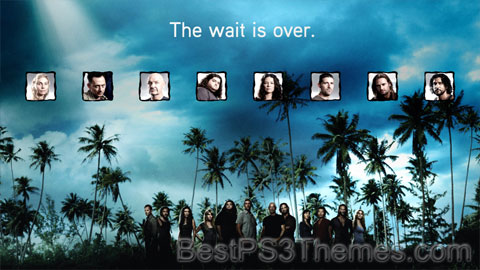
(1 background)
P3T Unpacker v0.12
Copyright (c) 2007. Anoop Menon
This program unpacks Playstation 3 Theme files (.p3t) so that you can touch-up an existing theme to your likings or use a certain wallpaper from it (as many themes have multiple). But remember, if you use content from another theme and release it, be sure to give credit!
Download for Windows: p3textractor.zip
Instructions:
Download p3textractor.zip from above. Extract the files to a folder with a program such as WinZip or WinRAR. Now there are multiple ways to extract the theme.
The first way is to simply open the p3t file with p3textractor.exe. If you don’t know how to do this, right click the p3t file and select Open With. Alternatively, open the p3t file and it will ask you to select a program to open with. Click Browse and find p3textractor.exe from where you previously extracted it to. It will open CMD and extract the theme to extracted.[filename]. After that, all you need to do for any future p3t files is open them and it will extract.
The second way is very simple. Just drag the p3t file to p3textractor.exe. It will open CMD and extract the theme to extracted.[filename].
For the third way, first put the p3t file you want to extract into the same folder as p3textractor.exe. Open CMD and browse to the folder with p3extractor.exe. Enter the following:
p3textractor filename.p3t [destination path]Replace filename with the name of the p3t file, and replace [destination path] with the name of the folder you want the files to be extracted to. A destination path is not required. By default it will extract to extracted.filename.
Lord of the Rings #4
Lord of the Rings theme by 1_BAD_SOLDIER
Download: LordOfTheRings_4.p3t
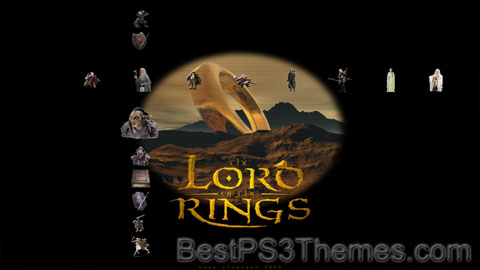
(5 backgrounds)
Redirect to:
This page is a redirect. The following categories are used to track and monitor this redirect:
|
Lord of the Rings #3
Lord of the Rings theme by MrToffee
Download: LordOfTheRings_3.p3t
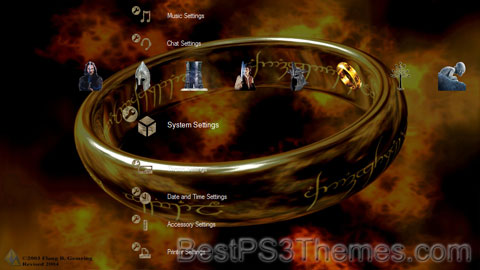
(7 backgrounds)
Redirect to:
This page is a redirect. The following categories are used to track and monitor this redirect:
|



